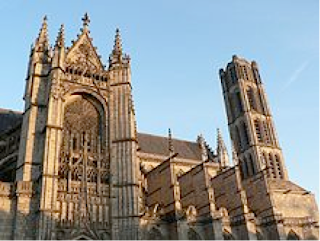After our quick stop through Castres, we left early in the morning and headed north on Avenue du Maréchal de Lattre de Tassigny/N141. Six hours and sixteen minutes later (it was a very scenic route) we arrived in Limoges. It is a city of 139,026 in Southwest-Central France.
In the 11th century, Limoges became a center of music and arts thanks to the presence of Abbey St Martial and its large library. During the French Revolution, the Abbey was razed (it was seen as part of the Ancien Régime), but much of its cultural impact remains.
Clearly we needed to get a good taste of Limoges porcelain, so our first stop was 8bis, place Winston Churchill; Musée national Adrien Dubouché (The French National Porcelain Museum). A law was passed in 1881 declaring the museum a national institution, and now contains large collections of pottery, tin-glazed earthenware, stoneware, porcelain, and glass from around the world. The entrance fee is 4,50 euros, but they offer a youth discount, so I got in for a clean 3. We enjoyed a guided tour and it was such a treat to see so many relics formed by hands of centuries past. We left only after buying lots of fragile souvenirs.
Here is some of what we saw:
After the museum, we decided to check out the gothic style Cathédrale St-Etienne, which dominates the landscape of the city. Of all the French cathedrals we visited, this was definitely our favorite. The Limoges tradition of art is quite evident inside:

“The cathedral contains two Renaissance works of great quality: a loft custom made by Bishop John Langeac, and the tomb of this bishop on which are carved scenes of the Apocalypse, inspired by Dürer. The walls of Romanesque crypt have beautiful frescoes representing Christ in glory. Some medieval paintings are still visible in some chapels (including representatives of angelic musicians) but almost all are frescoes of the 19th century. The Cathedral of Limoges has two organs. Hauptwerk, which was inaugurated by Gonzalez in 1963 and the Choir organ, installed in 1850.Every summer, the association of the cathedral organizes organ concerts to highlight the major organs of this building.”
After a full day talking in the arts of Limoges, we were so hungry. We forewent the fancy food and stopped off at Speed Rabbit Pizza, a national chain on Place Wilson. We were amused by some of the pizza names, which were clearly paying homage to the States. Among others, Speed Rabbit offers pizzas called: Alaska, Harlem, Indiana, Nebraska Beef, and Cooper Mountain. We decided on the Alsatian- a pizza topped with Creme Fraiche, Mozzarella, cheddar, onions, and double bacon. Even though it is a chain, it was much better than Domino’s or Pizza Hut.
Bellies full, we jumped back in our rented Peugeot and hit the road, destination unknown.

















